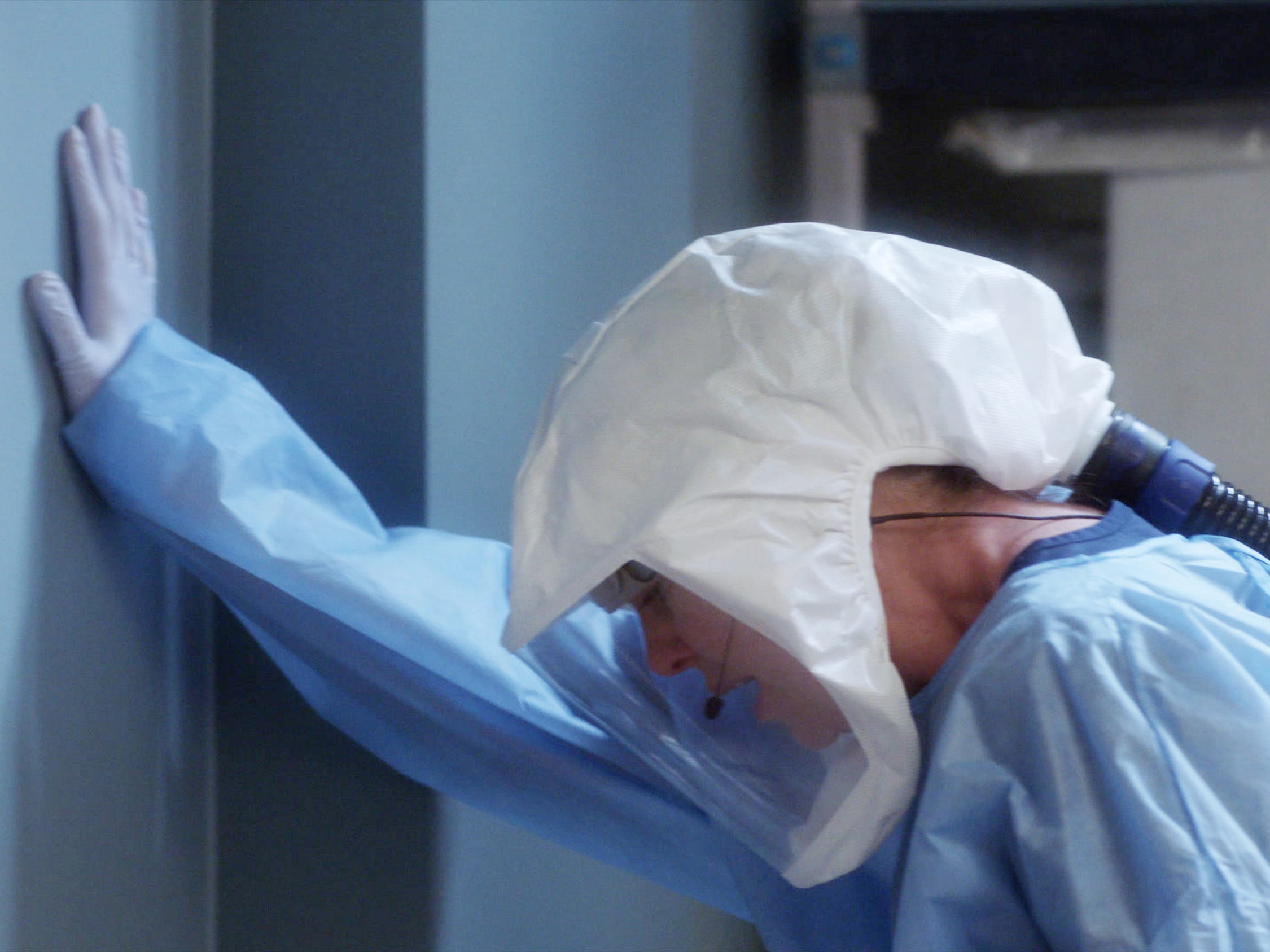
ABC
- I’ve spent the last nine months talking to nurses as a reporter, and I think “Grey’s Anatomy’s” portrayal of healthcare workers during the COVID-19 pandemic gets it right.
- “Grey’s Anatomy” characters act out the realities healthcare workers have faced, like staffing shortages and the mental toll of seeing so many patients die.
- The show has also educated viewers on the pandemic’s outsized impact on Black Americans, and explored ways to convince loved ones to wear masks.
- The show at times falls short in its portrayal by overusing PPE and hiding nurses, but I appreciate the attempt to educate viewers on the reality of the pandemic.
- Visit Business Insider’s homepage for more stories.
This article contains “Grey’s Anatomy” spoilers.
As “Grey’s Anatomy” patriarch Richard Webber watches N95-clad nurses turn the cafeteria into a makeshift COVID-19 unit, the former chief of surgery said, “I have never seen anything like this.”
The line feels hard to believe for a medical drama that featured a patient with a live bomb in his chest, a hospital shooter, and four characters miraculously surviving a plane crash. But Webber, played by James Pickens Jr., went on to explain how the drawn-out pandemic will demoralize healthcare staff.
“We’re doing our best, but this is the first time in my career I’m not sure that’s enough,” he said. “Pretty soon we’re gonna start losing our own. Not to the disease, but to the toll it’s taking. I fear this will hurt us in a way we can’t even begin to understand.”
In speaking with nurses as a reporter during the pandemic, I believe the scene captures the dire reality this country’s healthcare workers are facing right now.

Since March, I've talked to dozens of nurses on what they're experiencing on the frontlines. Numerous nurses broke down crying, and I often had to disguise my own cracking voice on the phone.
Ana, a nurse in California, said her hospital denied her paid time off to quarantine after she said she contracted COVID-19 at work. The single mom described the heartbreak she felt being only able to watch her young children, ages 4 and 1, play through her bedroom window.
An Oklahoma ER and ICU nurse called me alongside her mom, crying as she described her anxiety of contracting COVID-19 through her torn, reused masks and transmitting it to her loved ones. Another ICU nurse in Michigan said she's often the only one on her floor with more than a year's experience because many long-time staffers quit.
One nurse in Illinois who had cancer told me she quit her job after 42 years because she feared for her safety. (Business Insider confirmed the identities of nurses who wished to remain anonymous to protect their jobs).
"We're used to seeing death in the healthcare field, but not at this level," Sarah Curran, an ICU nurse in Michigan, told me. "It's every single day now, instead of before where it would be like, 'Oh, okay, that person died, that was unexpected.' But now it's getting to the point where it's every day."
Characters in "Grey's Anatomy" echoed some of these experiences. Surgeons treating COVID-19 patients like Meredith Grey (Ellen Pompeo) and Miranda Bailey (Chandra Wilson) talk to their kids through phone cameras while they isolate in hotels. Half of the hospital's new interns quit after one day.
Protagonist Meredith Grey knocked over equipment and sobbed after watching her patient die in the COVID-19 intensive care unit while his wife of 62-years waited outside.
"Who died?" another character asked, to which she replied, "Everyone."
"Grey's Anatomy" alludes to how the pandemic could have long-lasting impacts on healthcare.
When Richard Webber said healthcare workers doing their best "wasn't enough," I believe the character was alluding to the lack of support doctors and nurses received from healthcare institutions this year.
Frontline healthcare workers have told me hospitals and governments failed at providing paid sick leave, enough tests, and adequate hospital equipment to safely treat COVID-19 patients, highlighted through dystopian reports of American nurses treating patients while wearing garbage bags.

Doctors and nurses were at a breaking point before COVID-19 struck. Physician burnout reached an all-time high in 2019, according to the American Medical Association. Recent research from the University of California at San Diego found nurses had higher rates of suicide than the general population.
Nurse advocacy groups said they struggled receiving hospital support for issues like hospital violence and caring for too many patients at once. Research from the University of Pennsylvania School of Nursing found New York City hospitals were understaffed with nurses before the pandemic.
Got a tip? If you're a healthcare worker with a story to share, email [email protected].
Dennis Kosuth, an ER nurse in Chicago, said he blamed inadequate government public health education, not individuals, for the public's lack of mask wearing and social distancing that exacerbated the pandemic.
"I think if this country was truly interested in educating people, they would have mobilized forces to do that," Kosuth told me. "And I just haven't seen evidence of that."
By broadcasting the importance of mask wearing and the consequences of attending parties to 5.67 million viewers, I believe "Grey's Anatomy" has filled some education gaps. Characters explored ways to coax their loved ones to wear masks and to share intimate moments with their partners on FaceTime.
The show also educated viewers on COVID-19's outsized impact on Black, Indigenous and other communities of color: "Do you realize half of our COVID patients are Black and brown? In a city that's 7% Black?" Seattle-based plastic surgeon Jackson Avery (played by Jesse Williams) said.
The show isn't fully accurate, but laudably attempts to advocate for healthcare workers and other victims of the pandemic.
The show's portrayal has flaws. Healthcare workers pointed out the show's access to high-quality PPE didn't match the reality of workers still reusing masks. Nurses, who spend the most time with patients and died of COVID-19 at higher rates than doctors, were largely absent in Grey's Anatomy. And the show sometimes skirts coronavirus safety guidelines - I cringed when a COVID-19 positive doctor did not wear a mask when talking to a colleague.
Still, I appreciate that "Grey's Anatomy" is trying to highlight the pandemic's toll on healthcare workers and the rest of us.

"She should be in her own bed, not a sterile box. She spent 60 years taking care of me," said a husband who had to stay in a hotel room, unable to see his sick wife in the hospital. She died later in the episode after contracting COVID-19 at an assisted living facility.
"Grey's Anatomy" ended the episode with names of real Americans who had died from the disease.
-
- Read more:
- 'We're grossly unprepared': Nurses share their frustration as the coronavirus spreads with little direction from the government or hospitals on how to mitigate it
- Suicides among nurses are on the rise. Here's why one of America's fastest-growing jobs is facing a major crisis.
- Nurses say they're bracing for record-shattering COVID-19 hospitalizations after the holidays
- Filipinos make up 4% of nurses in the US, but 31.5% of nurse deaths from COVID-19
Dit artikel is oorspronkelijk verschenen op z24.nl

